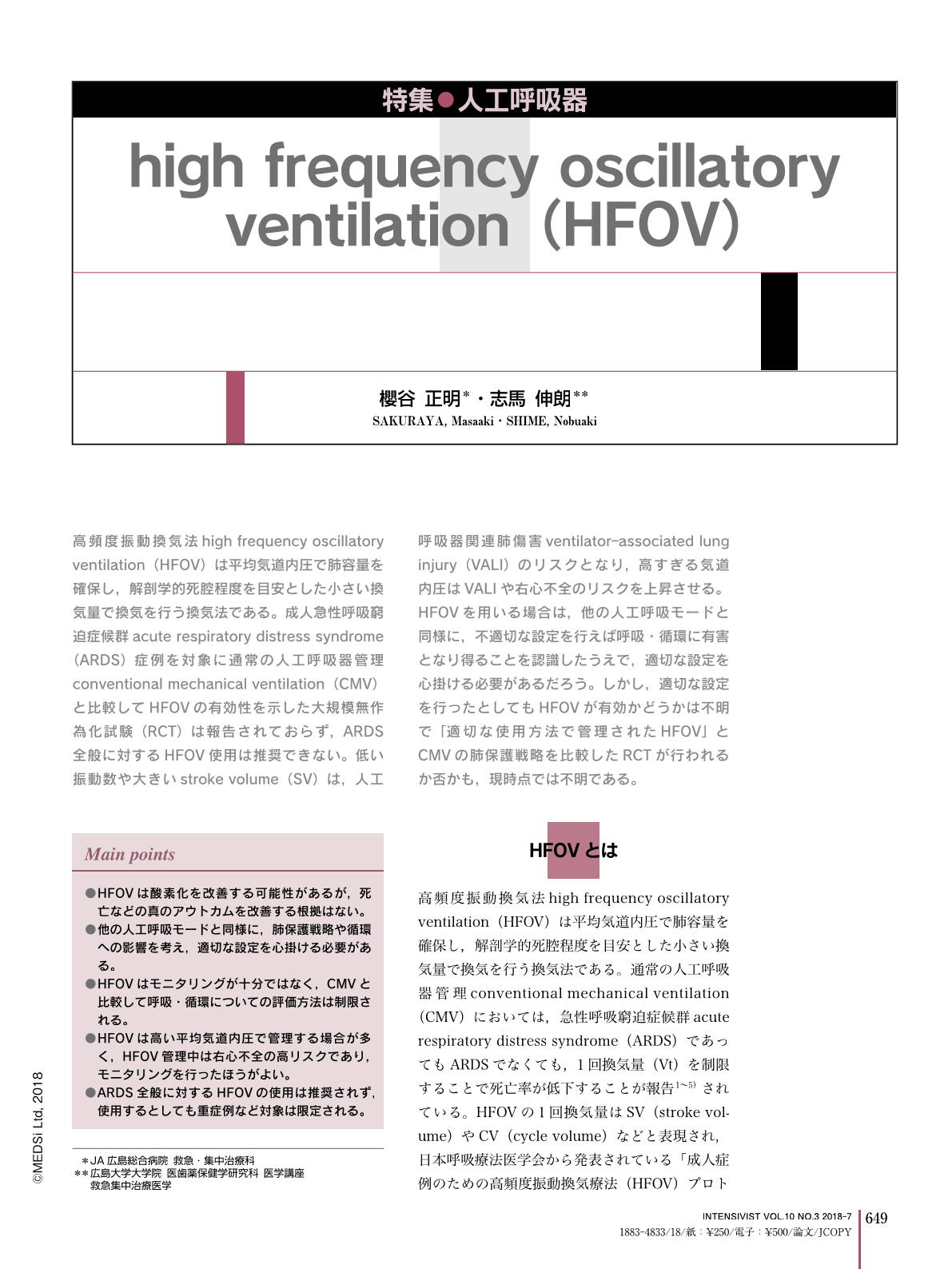Japanese
English
- 有料閲覧
- Abstract 文献概要
- 1ページ目 Look Inside
- 参考文献 Reference
高頻度振動換気法high frequency oscillatory ventilation(HFOV)は平均気道内圧で肺容量を確保し,解剖学的死腔程度を目安とした小さい換気量で換気を行う換気法である。成人急性呼吸窮迫症候群acute respiratory distress syndrome(ARDS)症例を対象に通常の人工呼吸器管理conventional mechanical ventilation(CMV)と比較してHFOVの有効性を示した大規模無作為化試験(RCT)は報告されておらず,ARDS全般に対するHFOV使用は推奨できない。低い振動数や大きいstroke volume(SV)は,人工呼吸器関連肺傷害ventilator-associated lung injury(VALI)のリスクとなり,高すぎる気道内圧はVALIや右心不全のリスクを上昇させる。HFOVを用いる場合は,他の人工呼吸モードと同様に,不適切な設定を行えば呼吸・循環に有害となり得ることを認識したうえで,適切な設定を心掛ける必要があるだろう。しかし,適切な設定を行ったとしてもHFOVが有効かどうかは不明で「適切な使用方法で管理されたHFOV」とCMVの肺保護戦略を比較したRCTが行われるか否かも,現時点では不明である。
Main points
●HFOVは酸素化を改善する可能性があるが,死亡などの真のアウトカムを改善する根拠はない。
●他の人工呼吸モードと同様に,肺保護戦略や循環への影響を考え,適切な設定を心掛ける必要がある。
●HFOVはモニタリングが十分ではなく,CMVと比較して呼吸・循環についての評価方法は制限される。
●HFOVは高い平均気道内圧で管理する場合が多く,HFOV管理中は右心不全の高リスクであり,モニタリングを行ったほうがよい。
●ARDS全般に対するHFOVの使用は推奨されず,使用するとしても重症例など対象は限定される。
High-frequency oscillatory ventilation (HFOV) is a unique mode of mechanical ventilation which uses non-conventional gas exchange mechanisms to deliver ventilation at very low tidal volumes and high frequencies. The present article reviews the physiological principles, basic concepts, clinical evidence, and practical applications of HFOV in adults with ARDS. HFOV was once considered an ideal lung-protective ventilatory mode. However, several randomized control trials failed to show improved patient survival with the use of HFOV despite positive effects on lung oxygenation. Inappropriate HFOV settings, especially higher mean airway pressure or stroke volume may contribute to the incidence of adverse events in patients with ARDS. Routine monitoring to evaluate pulmonary hypertension and right ventricular function should be performed when using HFOV, especially in patients with moderate or severe ARDS who are at high risk for acute cor pulmonale. Clinical limitations of HFOV include an inability to monitor end-tidal carbon dioxide, actual stroke volume and lung sounds. At this point, the indications for HFOV may be limited to a rescue mode for lethal hypoxemia in patients with severe ARDS.

Copyright © 2018, MEDICAL SCIENCES INTERNATIONAL, LTD. All rights reserved.


